<< Previous | Displaying results 6081-6090 of 6769 for "" | Next >>
This portrait from around 1922 depicts three generations of the Menaker family. The hairstyles and clothing highlight the process of acculturation–adapting to and even adopting elements of the dominant, non-Jewish culture–in one Jewish family in the Lwów region. The older female relative wears a wig and a dress with long sleeves and a high collar. Orthodox Jewish women traditionally wore modest clothing and covered their hair with wigs or kerchiefs. By contrast, Szprinca (center) wears a dress with…
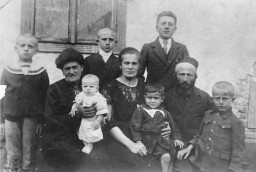
This 1935 portrait shows Samuel and Adela Shiber with three of their children—Salomon (left), Matylda (center), and Emanuel (right). The Shibers were a Jewish family from Lwów. Samuel owned a textile workshop in the city. Samuel and Adela spoke Yiddish at home, while the children spoke Polish among themselves. In this photo, there are no obvious markers of Jewish identity. The family wears clothing typical for middle or upper class families at the time. The children are dressed like most schoolchildren…
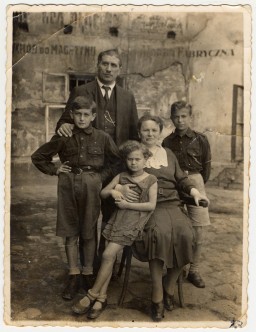
This prewar photo shows newly married Daniel and Laura (née Litwak) Schwarzwald enjoying a day on the beach in Zaleszczyki, Poland (today Zalishchyky, Ukraine). The Schwarzwalds were Jews from Lwów. They married in 1935 and lived in a fashionable Lwów district where Jews were a minority. Both Laura and Daniel pursued university educations and spoke Polish, Russian, German, and Yiddish. Daniel also spoke English. At the time of their marriage, Daniel was a successful businessman. He owned a lumber…

Propaganda played a crucial role in selling the myth of the "national community" (Volksgemeinschaft) to so-called "Aryan" Germans. The photograph on this cigarette card was taken by Nazi propagandist Heinrich Hoffman. It depicts a crowd of people smiling and giving the Nazi salute as a guard holds them back. Written in German, the caption on the back reads, "Every day the same picture: Fans welcome the leader." Beginning in the 1920s, cigarette cards were a popular collectible item in Germany. This card…
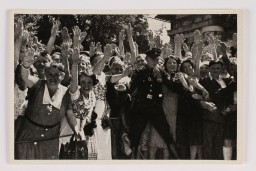
Sir Horace Rumbold was the British ambassador to Germany from 1928 to 1933. Rumbold described for the British government the changes he saw in Germany once Hitler came to power in January 1933. In a dispatch dated April 26, 1933, he warned of the principles outlined in Hitler's Mein Kampf and wrote that "the outlook for Europe is far from peaceful." Undated photograph. Library of Congress, Prints & Photographs Division, LC-DIG-ggbain-36812
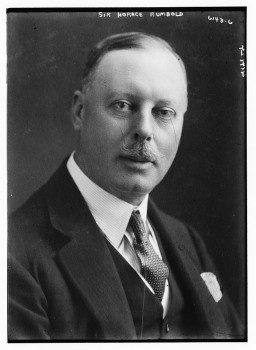
Standing in an open car, Adolf Hitler salutes a crowd in Hamburg, Germany. Photo dated August 17, 1934.
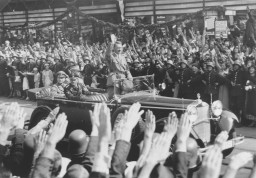
Hitler inspects a German naval warship. On his left is Admiral Erich Raeder. Standing to the right of Hitler is most likely Captain Hermann von Fischel, commander of the Deutschland from April 1, 1933, to December 29, 1935. Bremerhaven, Germany, circa 1933–1935.
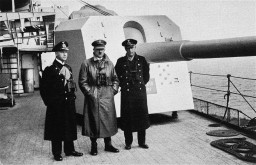
Portrait of British Prime Minister Neville Chamberlain. London, England, 1937–1940.
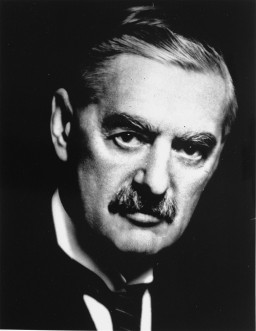
Members of the British Auxiliary Territorial Service carry rifles shipped from the United States under the Lend-Lease Act. Lend-Lease was a US policy that extended material aid to the Allies before and after the United States entered World War II.
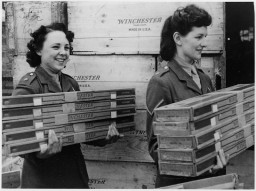
Wearing numbers, the defendants in the Bergen-Belsen Trial sit in the courtroom in Lüneburg, Germany. The Belsen Trial began on September 17, 1945, and was one of the first war crimes trials held after World War II. IWM (HU 59545)
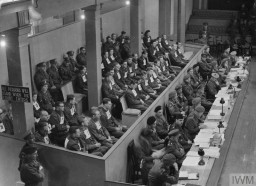
We would like to thank Crown Family Philanthropies, Abe and Ida Cooper Foundation, the Claims Conference, EVZ, and BMF for supporting the ongoing work to create content and resources for the Holocaust Encyclopedia. View the list of donor acknowledgement.